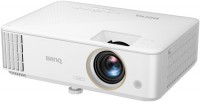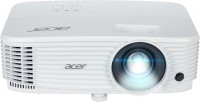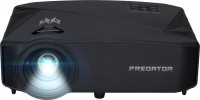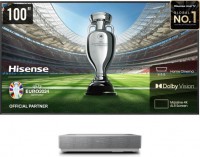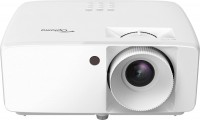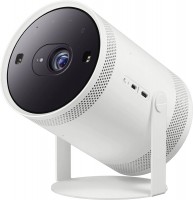Projectors BenQ
All Projectors Advanced filters → |
You might be interested in
Articles, reviews, useful tips
All materials
Mobile cinema: TOP-5 portable projectors with a built-in battery
These "portables" will help you deploy a cinema hall anywhere and anytime.

Deciphering the labeling of LG TVs
Features of labeling, decoding of designations and general standards of LG TVs

Chinese TVs: A Guide to Leading Brands
Chinese TV brands are gaining popularity

Home cinema: 5 LED home theater projectors
High-quality projectors with light sources on conventional and laser LEDs for creating a cinema hall at home

Why the USB4 standard is cool and why it is the future
Breaking down the most important things about the USB4 standard: speed, Thunderbolt integration, and Power Delivery

All about the Thunderbolt protocol
Let's figure out what the protocol from Apple and Intel is, why it is needed and why Thunderbolt is not the same as USB-C
Projectors: specifications, types
Show all
Main function
The main function of the projector.
This parameter is rather conditional, it largely depends on how the device is positioned by the manufacturer; however, for the most comfortable use, it is best to follow exactly the stated purpose. The options here can be: multipurpose, for presentations, for home theater, professional, portable..., gaming. Here is a more detailed description of each option:
— Multipurpose. The simplest kind of projectors, roughly speaking – all models that do not belong to any of the specializations described below. Most of them have non-interchangeable optics, a throw distance of 1-12 m, an image diagonal of about 1-7 m (see below), and a relatively low cost.
— For presentations. Projectors designed primarily for business use, such as presentations. Usually they have a small throw distance with a rather large diagonal, which allows them to be used in small rooms; capable of working with both widescreen and conventional image formats (see below), and also support resolutions typical for computer video cards — for example, 1280x800. In this case, the actual resolution itself (see below) can be quite low. In addition, an almost mandatory feature of this type of projectors (with a few exceptions) is the presence of a D-Sub 15 pin input (see "Connectors").
— For home theater. Projectors designed primarily for film viewing. The main criterion for classifying a particular model in this category is how the projector is positioned by the manufacturer itself (in other words, whether this purpose is indicated in the official documentation). However, there are some common features: cinematographic models usually support widescreen image formats, have a high real resolution (see below) that allows you to work with HD video, and are also equipped with the appropriate interfaces (see "Connectors").
— Professional. High-quality projectors with advanced parameters, an abundance of functions and, accordingly, a considerable price. They are characterized by high image contrast, support high-resolution video (including cinematic image formats), have optical zoom to scale the image without losing quality, provide the connection of multi-channel sound systems, and much more. The specific set of options in professional projectors may vary depending on the model, but in any case, these are the most charged devices with top-end characteristics.
— Portable projector. An ultra-compact variety of projectors: most models are pocket-sized. Such devices are intended primarily for improvised presentations. The format of work and power supply may be different. So, some models are made as separate devices with their own built-in storages and batteries (and sometimes even with a full-fledged mobile OS like Android on board). Others are similar in design to external cases or consoles and are put directly on the mobile phone during operation, using it as a source of signal and power. However, anyway, portable projectors, due to their small size, have rather low technical specifications — they have neither brightness nor high image contrast.. Battery life (in models with their own batteries) usually ranges from 40 minutes to one and a half hours. Also, this variety is characterized by cost-effective LED lamps (see below).
— Gaming. Specialized projectors designed for use in video games. Outwardly, they are often distinguished by a characteristic “aggressive” design, while the design can be done in the style of a certain line of gaming PCs or laptops. As for the specifications, they, in accordance with the name, are aimed primarily at providing a high-quality game "picture". To do this, projectors for this purpose provide, in particular, high real resolution (not lower than 1920x720, and more often 1920x1080 or more), colour reproduction at the level of 1 billion colours, support for frame rate (see below) up to 120 Hz, and also at least one HDMI input for receiving a digital signal from a computer graphics card. In addition, such models often provide support for 3D. The maximum image diagonal can reach 7.5 m or more; at the same time, ultra-wide-angle devices are also found in this category, capable of providing an image diagonal of about 3 m from a distance of about half a metre.
This parameter is rather conditional, it largely depends on how the device is positioned by the manufacturer; however, for the most comfortable use, it is best to follow exactly the stated purpose. The options here can be: multipurpose, for presentations, for home theater, professional, portable..., gaming. Here is a more detailed description of each option:
— Multipurpose. The simplest kind of projectors, roughly speaking – all models that do not belong to any of the specializations described below. Most of them have non-interchangeable optics, a throw distance of 1-12 m, an image diagonal of about 1-7 m (see below), and a relatively low cost.
— For presentations. Projectors designed primarily for business use, such as presentations. Usually they have a small throw distance with a rather large diagonal, which allows them to be used in small rooms; capable of working with both widescreen and conventional image formats (see below), and also support resolutions typical for computer video cards — for example, 1280x800. In this case, the actual resolution itself (see below) can be quite low. In addition, an almost mandatory feature of this type of projectors (with a few exceptions) is the presence of a D-Sub 15 pin input (see "Connectors").
— For home theater. Projectors designed primarily for film viewing. The main criterion for classifying a particular model in this category is how the projector is positioned by the manufacturer itself (in other words, whether this purpose is indicated in the official documentation). However, there are some common features: cinematographic models usually support widescreen image formats, have a high real resolution (see below) that allows you to work with HD video, and are also equipped with the appropriate interfaces (see "Connectors").
— Professional. High-quality projectors with advanced parameters, an abundance of functions and, accordingly, a considerable price. They are characterized by high image contrast, support high-resolution video (including cinematic image formats), have optical zoom to scale the image without losing quality, provide the connection of multi-channel sound systems, and much more. The specific set of options in professional projectors may vary depending on the model, but in any case, these are the most charged devices with top-end characteristics.
— Portable projector. An ultra-compact variety of projectors: most models are pocket-sized. Such devices are intended primarily for improvised presentations. The format of work and power supply may be different. So, some models are made as separate devices with their own built-in storages and batteries (and sometimes even with a full-fledged mobile OS like Android on board). Others are similar in design to external cases or consoles and are put directly on the mobile phone during operation, using it as a source of signal and power. However, anyway, portable projectors, due to their small size, have rather low technical specifications — they have neither brightness nor high image contrast.. Battery life (in models with their own batteries) usually ranges from 40 minutes to one and a half hours. Also, this variety is characterized by cost-effective LED lamps (see below).
— Gaming. Specialized projectors designed for use in video games. Outwardly, they are often distinguished by a characteristic “aggressive” design, while the design can be done in the style of a certain line of gaming PCs or laptops. As for the specifications, they, in accordance with the name, are aimed primarily at providing a high-quality game "picture". To do this, projectors for this purpose provide, in particular, high real resolution (not lower than 1920x720, and more often 1920x1080 or more), colour reproduction at the level of 1 billion colours, support for frame rate (see below) up to 120 Hz, and also at least one HDMI input for receiving a digital signal from a computer graphics card. In addition, such models often provide support for 3D. The maximum image diagonal can reach 7.5 m or more; at the same time, ultra-wide-angle devices are also found in this category, capable of providing an image diagonal of about 3 m from a distance of about half a metre.
Operating system
— Smart TV (proprietary system). The operating system of the projector is represented by the proprietary software shell of the manufacturer. Usually such operating systems have an attractive and convenient menu, similar to a traditional Smart TV. A proprietary operating system is developed by the manufacturer for the hardware resources of a particular projector model or a whole line. But, as practice shows, compared to the classic Smart TV, the functionality of...proprietary system often has significant limitations, and the system itself, in fact, is a stripped-down version of a full-fledged Smart TV.
— Smart TV (Android AOSP). This type of operating system is a modification of the popular Android OS, mainly notable for being open source. It is a versatile operating system that gives the user much more freedom to create changes and customizations within the system. At the same time, the installation and work stability of certain applications on this platform are not guaranteed, and the overall system management was not specially “tailored” for large screens, which may cause some inconvenience. First of all, such solutions will will generate interest among users who understand the features of the Android OS, like to customize and control everything, and have time for this.
— Android TV. This type of projector has full-fledged Android TV software, specially adapted to work on large screens. In accordance with the name, it is a type of Android OS, specially designed for projectors/TVs, etc. In addition to the common features of all “Androids” (such as the ability to install additional applications, including even games), it has a number of special features: optimized interface, integration with smartphones (including the ability to use them as a remote control), voice search, etc. Thanks to this, TVs with this feature are significantly superior in functionality to models with a Smart TV. Of course, a dedicated processor, graphics subsystem and memory are provided for the operation of a multifunctional OS, and the presence of such hardware resources is reflected in the total cost of the projector. Given the same optical design, models with Android TV will cost more than classic projectors with a simple multi-line menu.
No lens
No lens included with the projector. Having bought such a projector, you can choose and separately purchase a lens for it that is most suitable for your purposes, conditions of use, etc.; at the same time, you will not have to overpay for complete optics, which is not always the most suitable option.
Detachable lens
The presence of a detachable lens allows, if necessary, to replace the standard lens with another one with different parameters and capabilities. This feature not only makes the projector versatile (albeit at an additional cost), but also simplifies repairs in case of damage to the lens.
Lamp type
— HD (High-intensity discharge). General name for gas discharge lamps, i.e. lamps in which the light flow is created by an electrical discharge between the electrodes inside the bulb. In the case of projectors, such lamps can be mercury, metal-halide, and xenon (see above for more details).
— LED. LEDs are used as a light source. They provide high brightness with low power consumptio...n.
— Laser-LED. Light source based on laser LEDs. It has even greater brightness than classic LED, with relatively low power consumption.
— UHP (Ultra-high performance) — a high-pressure mercury lamp, developed by Philips. Compared to other lamps, it consumes less power, while not inferior in brightness. Projectors on such lamps are smaller and lighter than conventional ones due to a smaller power supply, the cooler operates with a lower noise level. The creators claimed a service life of up to 10,000 hours. One of the most popular types of lamps for projectors today
– UHE (Ultra-High Energy). Variety of UHP lamps (see above).
— UHB (Ultra-high brightness). Another kind of UHP lamps (see above).
— NSH (New Super High Pressure). Also applies to high pressure mercury lamps manufactured by Ushio. Somewhat less popular than UHP and its peers, but also widespread. Estimated operating time is about 2000 hours.
— SHP. High pressure mercury lamps manufactured by Phoenix.
— P-VIP (Video Projector) — a high-pressure mercury lamp from OSRAM. High brightness lamps, service life — 4000 — 6000 hours.
—UHM (Ultra High Performance Lamp of Matsushita) is a high pressure mercury lamp manufactured by Panasonic. Сan be easily changed, operating time, depending on type — 2000 — 5000 hours.
— Xenon. The design and principle of operation of such lamps are similar to high-pressure mercury lamps — light is created due to a discharge in a gaseous medium. However, instead of mercury vapor, in this case, an inert xenon gas under high pressure is used. This allows to create high power lamps (from 2 kW) with the appropriate light flow. Xenon lamps are used primarily in professional models.
— HPM. High-pressure mercury lamp technology developed by Sony and used primarily in its projectors (although other brands are also available). Combines compact size and relatively low cost with high brightness.
— DC. Abbreviation for "direct current". In the case of projector lamps, this designation usually refers to mercury lamps powered by direct current. The operating voltage of such lamps in different models of projectors may be different. Their design usually uses various tricks to improve performance compared to conventional lamps of this type — in particular, increase service life and reduce power consumption without sacrificing brightness.
— AC. This abbreviation stands for "alternating current". Such lamps are similar in almost everything to the DC ones described above, differing from them only in the type of power supply.
— LED. LEDs are used as a light source. They provide high brightness with low power consumptio...n.
— Laser-LED. Light source based on laser LEDs. It has even greater brightness than classic LED, with relatively low power consumption.
— UHP (Ultra-high performance) — a high-pressure mercury lamp, developed by Philips. Compared to other lamps, it consumes less power, while not inferior in brightness. Projectors on such lamps are smaller and lighter than conventional ones due to a smaller power supply, the cooler operates with a lower noise level. The creators claimed a service life of up to 10,000 hours. One of the most popular types of lamps for projectors today
– UHE (Ultra-High Energy). Variety of UHP lamps (see above).
— UHB (Ultra-high brightness). Another kind of UHP lamps (see above).
— NSH (New Super High Pressure). Also applies to high pressure mercury lamps manufactured by Ushio. Somewhat less popular than UHP and its peers, but also widespread. Estimated operating time is about 2000 hours.
— SHP. High pressure mercury lamps manufactured by Phoenix.
— P-VIP (Video Projector) — a high-pressure mercury lamp from OSRAM. High brightness lamps, service life — 4000 — 6000 hours.
—UHM (Ultra High Performance Lamp of Matsushita) is a high pressure mercury lamp manufactured by Panasonic. Сan be easily changed, operating time, depending on type — 2000 — 5000 hours.
— Xenon. The design and principle of operation of such lamps are similar to high-pressure mercury lamps — light is created due to a discharge in a gaseous medium. However, instead of mercury vapor, in this case, an inert xenon gas under high pressure is used. This allows to create high power lamps (from 2 kW) with the appropriate light flow. Xenon lamps are used primarily in professional models.
— HPM. High-pressure mercury lamp technology developed by Sony and used primarily in its projectors (although other brands are also available). Combines compact size and relatively low cost with high brightness.
— DC. Abbreviation for "direct current". In the case of projector lamps, this designation usually refers to mercury lamps powered by direct current. The operating voltage of such lamps in different models of projectors may be different. Their design usually uses various tricks to improve performance compared to conventional lamps of this type — in particular, increase service life and reduce power consumption without sacrificing brightness.
— AC. This abbreviation stands for "alternating current". Such lamps are similar in almost everything to the DC ones described above, differing from them only in the type of power supply.
Lamp model
The lamp model that the projector is designed for. Most projectors come with lamps included, so this information is not needed for normal use. But when looking for a spare lamp or replacement, information about model can be very useful: finding a spare part by the exact name is much easier than by general data like the brand of the projector.


